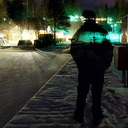2 Likes
Otras imágenes de Bengolea en http://www.panoramio.com/user/1741212
En Bengolea se manifestó desde los primeros años de existencia del pueblo la devoción por San Grato, protector de los cultivos contra langostas, gusanos y pestes, defensa contra las tempestades e incendios, y ayuda de lluvia en los períodos de sequía.
La imagen del Patrono fue regalada por una familia fundadora del pueblo, la de don Giuseppe Marcellino en 1906, año en que se realizó la primera fiesta patronal el 7 de Setiembre con misa solemne y procesión con la presencia de Monseñor Juan B. Fassi.
La construcción del templo definitivo, comenzada en 1918, demandó años de recolección de donaciones y trabajos comunitarios; parte de las paredes se derrumbaron en 1921 pero siguieron con el esfuerza de todo el pueblo chacarero y especialmente de la fila. Marcellino, en cuyo campo se horneaban los ladrillos para la construcción.
El templo fue bendecido el 6 de Setiembre de 1926, aún sin concluir, y el 7 de Setiembre de 1927 se ofició la primera misa en el flamante templo.
Junto a la imagen de San Grato fue colocada una de San José como segundo patrono del pueblo, y una de la Virgen de la Guarda.
Por aquellos años oficiaba de sacristán don Remigio Cuello con la ayuda de su esposa Teresa. Pronto se contó con un armonio, ejecutado por Nelly Maglione, Clotilde Cuello y Olga Bonnet, acompañado en oportunidades por un coro femenino.
El párroco Macció, en los años 60 introdujo la misa dominical semanal, que hasta entonces había sido mensual o quincenal. Se hacía una misión rural y una novena a San Antonio en la capilla construida en la zona de Colonias Unidas. Años después se comenzó con la misión rural en Colonias “Las Merceditas”, donde se apoyó la construcción de una escuela rural.
Con los años se le realizaron importantes mejoras a la Capilla: se retiraron las verjas de hierro del frente y se construyó una explanada con escalones, se construyó un salón multiuso y un departamento para uso de los sacerdotes.
En el 2003 el Párroco Principi comenzó con la restauración del templo y las imágenes con ayuda de fieles, vecinos, empresas e instituciones, arreglo del techo, cura de humedad, pintura, etc.
El actual Párroco Frega lleva adelante la remodelación de la fachada del templo y casa-habitación, colocando en el frente la escultura del Sagrado Corazón de Jesús.
Texto publicado en la revista “Vida parroquial” en su edición especial de Agosto de 2012





Argentina didn't get to be the second-largest country in South America overnight. Archaeological remains found here date to some 9,000 years BC, left by the ancient Mesoamerican civilization. Early inhabitants were nomads and hunters who followed prehistoric horses and llamas. By the year 1480 AD the Incan empire had stretched to reach northern Argentina and the stage was set for contact.The Europeans came in 1516 with Spanish explorer Juan Diaz do Solis, who claimed the area for Spain and tried to export a river of silver back to Europe. Wealth grew along with the cattle industry and after Napoleon conquered Spain, Argentina declared its independence and set up their own government. That was 1810 AD.Argentina stayed neutral in WWI and for most of WWII, declaring war on the Axis powers only in 1945. Following the war, the country entered into a long chain of military dictatorships with only brief forays into constitutional government. The current president is Cristina Fernandez de Kirchner, who's been in office since December 2007.Argentina is known for many things but the top of the list belongs to only two -- steak and the tango. Cattle graze on the abundant grasslands and produce some of the best beef in the world. The climate is well-suited for vineyards as well, and Argentina's wines make a fine companion to their steak.As for the tango, it has recently exploded to become a world famous dance with hotspots in every major city on the planet. It started in Buenos Aires in the middle of the nineteenth century, as the city was filling up with a mixture of European immigrants and porteños, people who were born in the port city. They melded their cultures of rhythm and harmony and came up with the tango, which has been described as the ultimate evolution of partnered dancing. And it's a great way to burn off your steak stupor. Food coma begone!Text by Steve Smith.